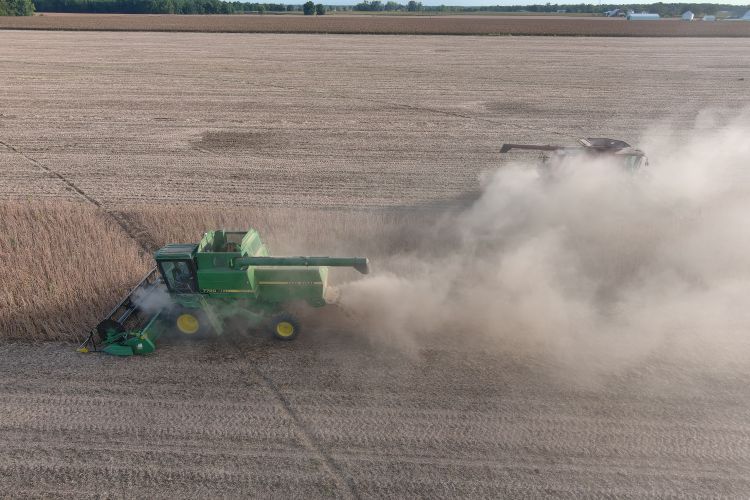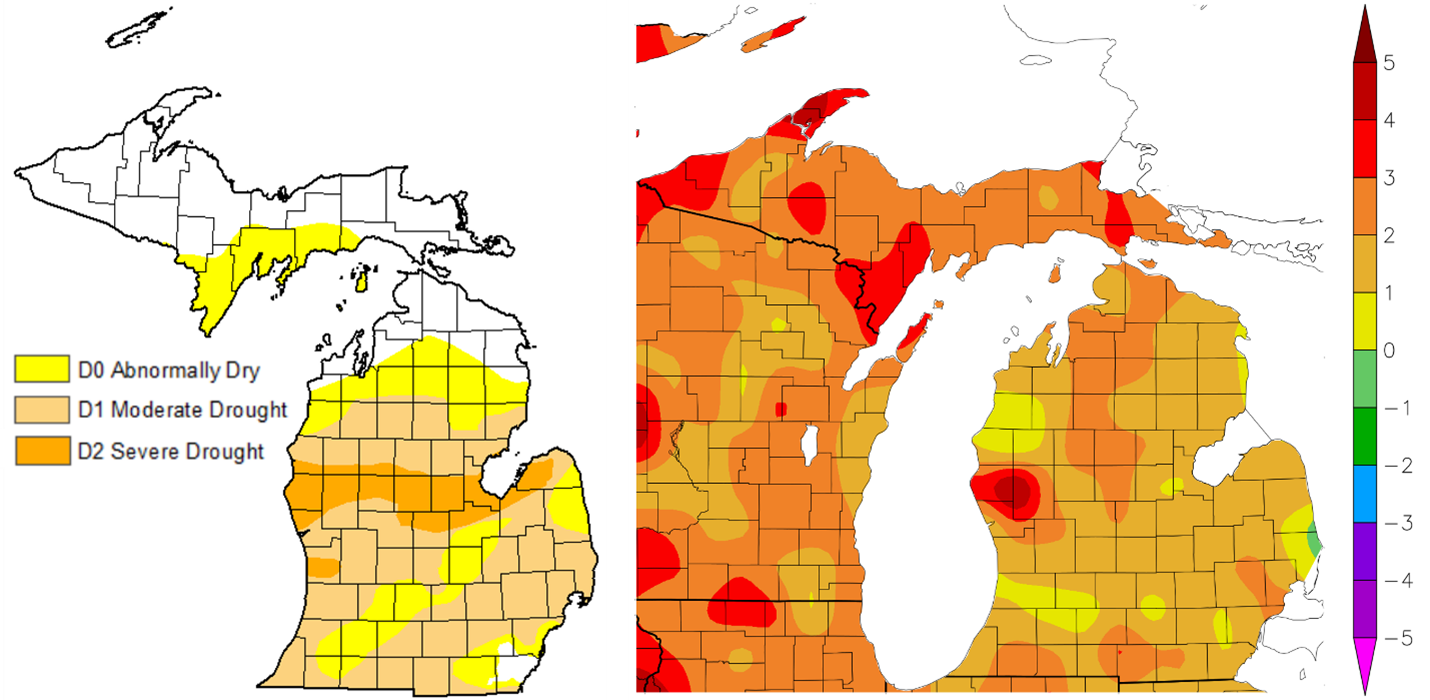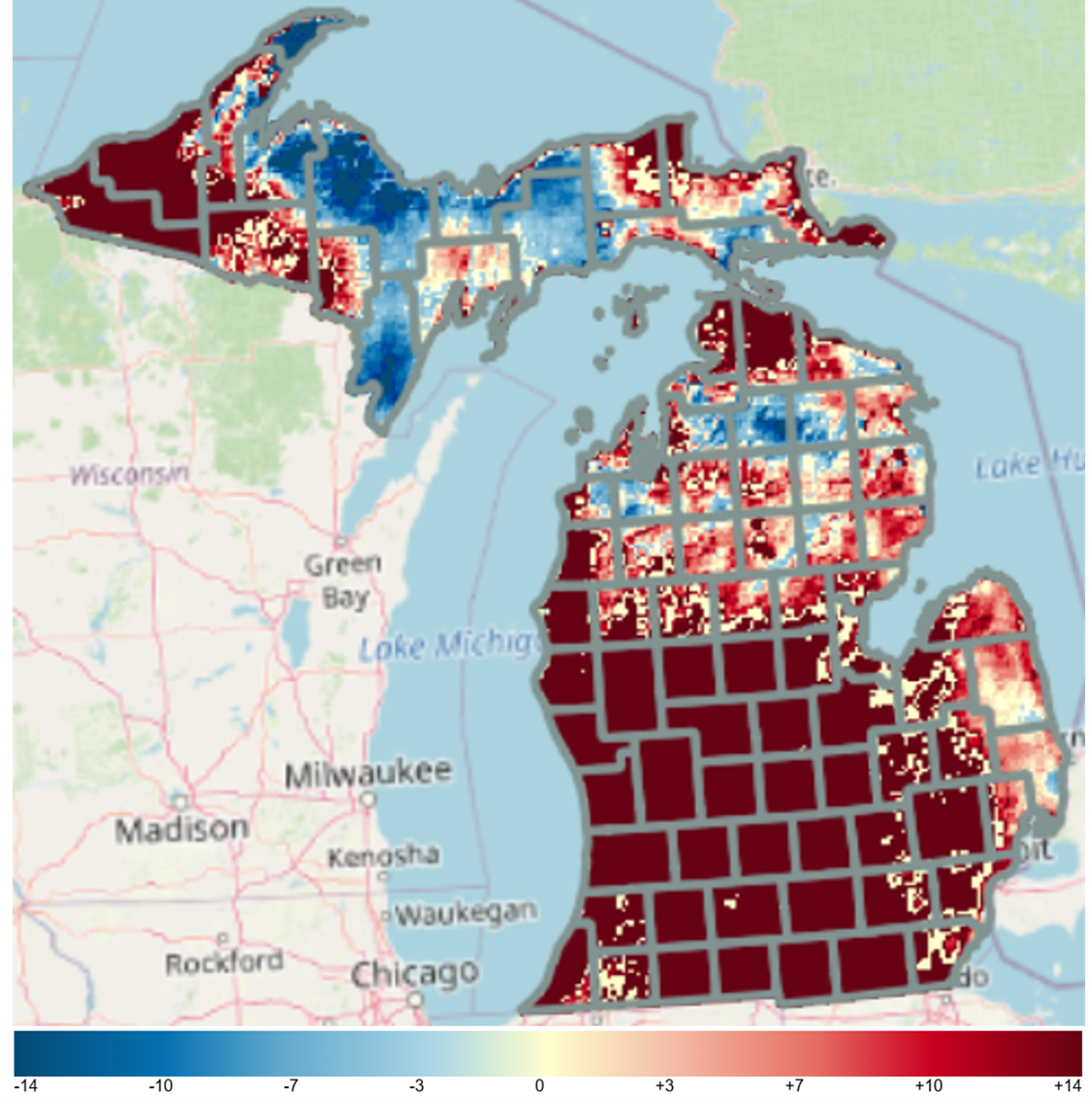Thinking about reconditioning overly dry soybeans?
There are a few factors to consider when looking to raise moisture levels of soybeans during storage.

Soybean harvest began early this year, similar to 2024, as near-drought or drought conditions caused the crop to reach maturity and dry down quicker than many farmers anticipated. Soybean harvest began in many fields during the third week of September in Michigan with warmer-than-normal and dry conditions prevalent in the southern half of the Lower Peninsula (Figure 1). Most areas south of Highway 10, outside of the Thumb, were more than 14 days ahead of normal as of Sept. 30, 2025, with respect to accumulated heat units (Figure 2).


The decision to try to adjust grain moisture levels during on-farm storage is essentially an economic one—will it cost more to operate (and possibly purchase) the equipment to increase moisture levels than farmers will receive in additional revenue? Table 1 provides estimates of differences in revenue at different soybean moisture levels. Using the cost of electricity for running the equipment (and possible purchase and installation costs for needed new equipment) to increase moisture levels, the breakeven cost of reconditioning can be easily calculated.
Table 1. Net value per acre for a 60-bushel-per-acre soybean yield harvested and delivered at 13% moisture versus harvesting and delivering at other moisture levels.
|
Moisture (%) |
Wet bushels/acre |
Moisture Shrink (%) * |
Pay bushels at 13% (bu/ac) ** |
Drying charge ($/bu) *** |
Net value ($/ac) **** |
Net value ($/bu) |
Loss versus harvesting at 13% ($/bu) |
|---|---|---|---|---|---|---|---|
|
18 |
63.66 |
7 |
59.2 |
0.25 |
$577.20 |
$9.62 |
- $0.38 |
|
17 |
62.89 |
5.6 |
59.37 |
0.2 |
$581.83 |
$9.70 |
- $0.30 |
|
16 |
62.14 |
4.2 |
59.53 |
0.15 |
$586.37 |
$9.77 |
- $0.23 |
|
15 |
61.41 |
2.8 |
59.69 |
0.1 |
$590.93 |
$9.85 |
- $0.15 |
|
14 |
60.7 |
1.4 |
59.85 |
0.05 |
$595.51 |
$9.93 |
- $0.07 |
|
13 |
60 |
0 |
60 |
0 |
$600.00 |
$10.00 |
$0.00 |
|
12 |
59.32 |
0 |
59.32 |
0 |
$593.20 |
$9.89 |
- $0.11 |
|
11 |
58.65 |
0 |
58.65 |
0 |
$586.50 |
$9.78 |
- $0.23 |
|
10 |
58 |
0 |
58 |
0 |
$580.00 |
$9.67 |
- $0.33 |
|
9 |
57.36 |
0 |
57.36 |
0 |
$573.60 |
$9.56 |
- $0.44 |
|
8 |
56.74 |
0 |
56.74 |
0 |
$567.40 |
$9.46 |
- $0.54 |
*Dry bushels were calculated using a shrink factor of 1.4% per wet bushel for each 1% above 13%.
** Pay bushel loss was calculated based on the same dry matter when moisture was below 13%.
*** Moisture discount/drying charge of $0.05 for each 1% above 13% was applied to wet bushel, actual cost will vary by location.
**** Market price is $10.00 per bushel (USDA 2025-2026 season-average soybean farm price, updated Sept. 16, 2025).
It is illegal to add water to any grain crop. However, it is legal to increase the moisture level of the beans by running aeration fans only when humidity levels are high. Be aware that adding too much moisture may damage the bins. Ken Hellevang at North Dakota State University (NDSU) has written several articles on reconditioning soybeans: “Consider Reconditioning Too-dry Soybeans and Other Grain,” “Soybeans May Need Rewetting” and “Reconditioning Soybeans in Storage Poses Problems.”
In a recent article, “Practical Considerations when Reconditioning Overly Dry Soybeans,” Dirk Maier, PhD, and Tony Mensing of Iowa State University Extension explain four approaches to reconditioning soybeans.
- Standard bin setup with updraft aeration. Positive-pressure systems are the most common in permanent bin storage. Ideal relative humidity levels for reconditioning are between 60 and 90% with an average of 70%. Introducing air with very high relative humidity is not recommended as spoilage can occur. Keep in mind that the air temperature will rise 3-5 degrees Fahrenheit as it passes through the fan, which will slightly lower the relative humidity in the air. Because reconditioning involves moving moist air through the grain mass, it is best performed in drying bins having perforated floors and fans rated at delivering at least 0.75 cubic feet per minute per bushel.
Soybean grain moisture will equilibrate at a given temperature and relative humidity (Table 2). The process can take several months, especially during winter when relative humidity levels are lower or when fan motors are sized to move air at a slower rate. As moist air is pulled in through fans at the bottom of the bin during periods of high relative humidity, a moisture gradient forms with a “wetting front” slowly progressing up the bin. To address this concern, the remaining three approaches can be used.
Table 2. Soybean equilibrium moisture values by temperature and relative humidity (RH). Excerpted from “Considerations when Conditioning Too-dry Soybeans,” NDSU.
|
Temperature |
50% RH |
60% RH |
70% RH |
80% RH |
90% RH |
|---|---|---|---|---|---|
|
32 F |
10.0% |
11.8% |
13.7% |
16.2% |
19.8% |
|
40 F |
9.8% |
11.5% |
13.5% |
16.0% |
19.6% |
|
50 F |
9.5% |
11.2% |
13.2% |
15.7% |
19.4% |
|
60 F |
9.2% |
11.0% |
13.0% |
15.4% |
19.1% |
|
70 F |
8.9% |
10.7% |
12.7% |
15.2% |
18.9% |
|
80 F |
8.6% |
10.4% |
12.5% |
15.0% |
18.7% |
- Modified bin setup with downdraft aeration. Creating negative pressure by pulling air out from the bottom of the grain column will reverse the moisture gradient. Subsequent, repeated “last-in, first-out” unloading cycles then remove the soybeans as they are reconditioned. Reversing fan direction may be feasible with an axial flow fan that is unbolted and rebolted in the opposite direction, but it is not advised to rewire a fan to simply reverse the flow. Consult with your local grain bin specialist to see if these modifications are possible with your current equipment.
- Modified bin setup with a STIG DRI-Stack System. This system distributes airflow from the perforated floor to specific layers within the grain column through stacks installed within the bin.
- Standard bin setup with updraft aeration and a stirring system. Stirring equipment is used to equalize temperature and moisture levels throughout the grain column. Concerns have been raised about the possibility of damaging soybeans at very low moisture levels with stirring, but the Iowa State University Extension authors suggest that may not be as much of an issue when only running the stirring equipment intermittently, i.e. only once or twice a month. Hellevang from NDSU cautions against increasing soybean moisture beyond 1-2% to minimize the risk of damage to the grain bin as the grain swells. This risk may be lessened as stirring equipment creates vertical movement in the bin, redistributing the grain and alleviating some of the pressure.
Although it is possible to monitor grain moisture in the bin manually, Michigan State University Extension recommends using equipment that will continuously monitor temperature and humidity in the grain column and in the head space. This is particularly true when using systems that will turn fans on and off depending on the relative humidity of the outside air and the grain bin readings. One method is to add two humidistats to control the fan—one to turn the fan on when humidity is above 60% and another to shut the fan off when the humidity is above 90%. Another option is to install a microprocessor-based controller that monitors temperature and humidity.
For more information about reconditioning, drying, handling and storing soybeans, see NDSU’s Grain Drying and Storage website.



 Print
Print Email
Email